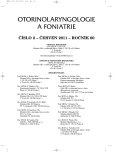Comparison of Basic Diagnostic Methods (Reflux SymptomIndex, Reflux Finding Score, Therapeutic Trial, pH-metry)
Authors:
Karol Zeleník
; H. Kopřivová; Pavel Komínek
Authors‘ workplace:
Otorinolaryngologická klinika FN Ostrava
přednosta doc. MUDr. P. Komínek, Ph. D., MBA
Published in:
Otorinolaryngol Foniatr, 60, 2011, No. 2, pp. 71-77.
Category:
Original Article
Overview
Objective:
The aim of the study is to compare the importance of basic methods used in the diagnosis of extraesophageal reflux (EER) - Reflux symptom index (RSI), Reflux finding score (RFS), therapeutic trial (TT) and pH-monitoring.
Methods:
Patients with typical symptoms of the EER (especially hoarseness, throat cleaning, coughing and globus pharyngeus) lasting at least three months and/or symptoms of reflux laryngitis were included in the study. Demographic data, RSI and RFS were recorded. Subsequently, pH-metry was performed and patients were put on proton pump inhibitor trial for 12 weeks.
Results:
Pathological EER was detected in 24.9% of patients coming to the ENT clinic with symptoms of EER. The other 38.3% of patients had episodes of EER, but these were not severe enough to meet criteria for pathological EER. The mean RSI of patients with pathological EER was 21.86, in patients without EER according to pH-monitoring was 17.68. The difference was not statistically significant. The mean RFS in patients with pathological EER was 8.57, in patients without EER according to pH-monitoring was 6.16. The difference was statistically significant. Between the RSI and RFS was found only a very weak positive correlation. Patients with positive TT had significantly higher values of RSI, and had significantly more often pathological EER demonstrated with pH-monitoring.
Conclusions:
Pathological EER was demonstrated in a quarter of patients coming to the ENT clinic with clinical symptoms of EER. Pathological diagnosis of EER is very likely if the RSI is greater than 20 and/or the RFS is higher than 7. TT was confirmed to be a useful diagnostic instrument; however pH-monitoring is the most accurate diagnostic method for detection of EER.
Keywords:
extraesophageal reflux, pH-monitoring, Reflux symptom index, Reflux finding score, therapeutic trial.
Sources
1. Ayazi, S., Lipham, J. C., Hagen, J. A. et al.: A new technique for measurement of pharyngeal pH: normal values and discriminating pH threshold. J. Gastrointest Surg., 13. 2009, s. 1422-1429.
2. Belafsky, C. P., Postma, G. N., Koufman J. M.: Validity and reliability of the reflux symptom index (RSI). J. Voice,, 16, 2002, s. 274-277.
3. Belafsky, C. P., Postma, G. N., Koufman J. M.: The validity and reliability of the reflux finding score. Laryngoscope, 111, 2001, s. 1313-131.
4. Belafsky, P. C.: Debate: Treatment of chronic throat symptoms with PPIs should be preceded by pH monitoring. Pro: Empiric treatment with PPIs Is. Not appropriate without testing. Am. J. Gastroenterol., 101, 2006, s. 6-11.
5. Devault, K.: Debate: Treatment of chronic throat symptoms with PPIs should be preceded by pH monitoring. A balancing view: Empiric PPI therapy remains the champ, but not by a knock out! Am. J. Gastroenterol., 101, 2006, s. 6-11.
6. Fossmark, R., Johnsen, G., Johanessen, E. et al.: Rebound acid hypersecretion after long-term inhibition of gastric acid secretion. Aliment Pharmacol Ther., 21, 2005, s. 149-154.
7. Jecker, P., Schuon, R., Morales, C. et al.: Normalwertbestimmung des extraösophagealen Reflux (EER) in der 24-h-2-Kanal-pH-Metrie. HNO, 56, 2008, s.1040-1045.
8. Merati, A. L., Lim, H. J., Ulualp, S. O. et al.: Meta-analysis of upper probe measurements in normal subjects and patients with laryngopharyngeal reflux. Ann. Otol Rhinol. Laryngol.,114, 2005, s. 177-182.
9. Mesallam, T. A., Stemple, J. C., Sobeith, T. M. et al.: Reflux Symptom Index versus Reflux Finding Score. Annals of otology, Rhinology and Laryngology, 116, 2007, s. 436-440.
10. Oelschlager, B. K., Eubanks, T. R., Maronian, N. et al.: Laryngoscopy and pharyngeal pH are complementary in the diagnosis of gastroesophageal-laryngeal reflux. J. Gastrointest Surg., 6, 2002, s. 189-194.
11. Postma, G. N., Belafsky, P. C., Aviv, J. E. et al.: Laryngopharyngeal reflux testing. Ear, Nose & Throat Journal, 81, 2002, s. 14-18.
12. Reichel, O., Issing, W. J.: Impact of different pH thresholds for 24-hour dual probe pH monitoring in patients with suspected laryngopharyngeal reflux. The Journal of Laryngology & Otology, 122, 2008, s. 485-489.
13. Reulbach, T. R., Belafsky, P. C., Blalock, P. D. et al.: Occult laryngeal pathology in a community-based cohort. Otolaryngol. Head Neck Surg., 124, 2001, s. 448-450.
14. Sato, K., Umeno, H., Chitose, S. et al: Patterns of laryngopharyngeal and gastroesophageal reflux. The Journal of Laryngology & Otology, 123, 2009 (Suppl. S31), s. 42-47.
15. Smit, C., Tan, J., Devriese, P. et al.: Ambulatory pH measurements at the upper esophageal sphincter. Laryngoscope, 108, 1998, s. 299-302.
16. Veldová, Z.: Možnosti léčby hlasových profesionálů v ambulantní praxi. Interní medicína pro praxi, 11, 2005, s. 496-498.
17. Zeleník, K., Kopřivová, H., Stárek, I. et al.: Reflux finding score. Otorinolaryng. a Foniat. /Prague/, 59, 2010, s. 28-31.
18. Zeleník, K., Matoušek, P., Urban, O. et al.: Globus pharyngeus and Extraesophageal Reflux: Simultaneous pH <4.0 and pH <5.0 analysis. Laryngoscope, 120, 2010, s. 2160-2164.
19. Zeleník, K., Schwarz, P., Urban, O. et al.: Extraezofageální reflux up-to-date. Čes. a Slov. Gastroent. a Hepatol., 64, 2010, s. 10-14.
Labels
Audiology Paediatric ENT ENT (Otorhinolaryngology)Article was published in
Otorhinolaryngology and Phoniatrics

2011 Issue 2
Most read in this issue
- Changes in Communication are the Biggest Handicap in Patients with Permanent Tracheostomy
- Extraesophageal Reflux Disease – Interdisciplinary Consensus
- Pendred Syndrome in the Czech Republic
-
Tumour Thrombosis of Internal Jugular Vein
A Case Report and Overview of Its Epidemiologic, Pathogenetic and Clinical Aspects
